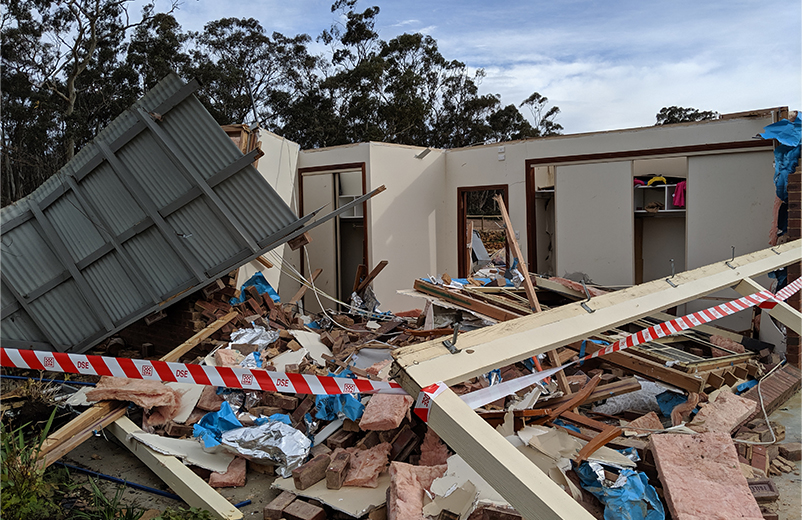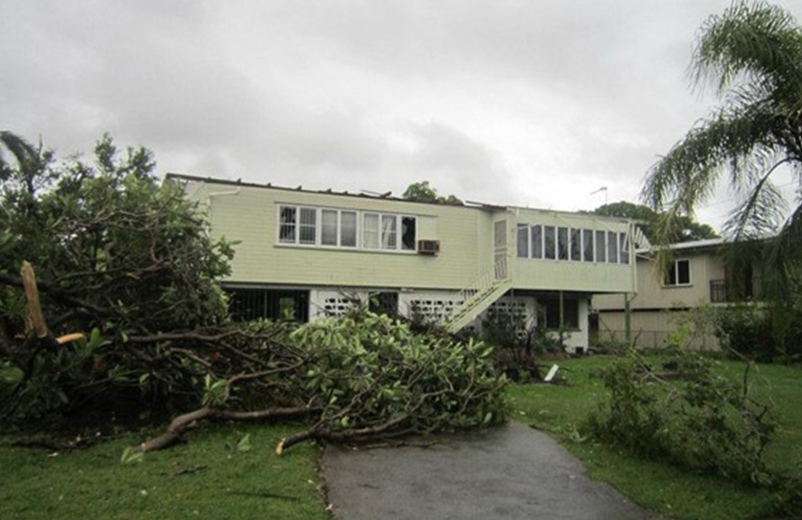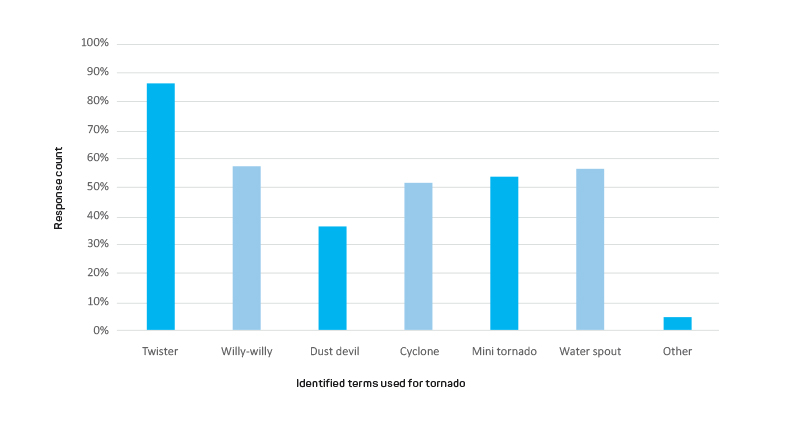Australian summers are periods of extensive and severe weather events. This often includes rapid-onset events of intense rainfall, flooding, hail, damaging winds and, in some instances, reported tornadoes. Associated with severe thunderstorms, a tornado is a small-scale vortex or column of destructive rotating winds appearing as a funnel-shaped cloud touching the ground. Meteorological research by Allen and co-authors (2021) indicates that Australia experiences an estimated 60 tornadoes a year, all with significant potential for damage, injuries and fatalities in populated areas. Despite the apparent risk, a review of relevant literature and recent social media posts suggests there is limited community awareness and understanding of tornadoes in Australia. A research project was developed to gauge levels of existing knowledge and capacity from a disaster management perspective. The first phase was an online survey to assess community experience, awareness and preparedness related to tornadoes in Australia. Results from this survey highlighted issues of inconsistent terminology, variable understanding and limited preparedness. Importantly, almost 5% of survey respondents believed tornadoes did not occur in Australia. Subsequent surveys will investigate the perspectives of current weather forecasters and emergency service personnel towards developing improved integrated risk management approaches for such events.
Introduction
While people in Australia are familiar with the threat of tornadoes usually from movies, the news or other media footage, much of this has been based on events and experiences in the USA. Many people have the prevailing myth that tornadoes do not occur in Australia. While there are eyewitness accounts of tornadic activity dating back to 1795 (Bureau of Meterology 2019), the documented evidence of tornadoes in Australia has been sporadic and inconsistent. Research by Allen and co-authors (2021) suggests that Australia experiences up to 60 tornadoes per year, but they are predominantly in sparsely populated locations. As human settlement expands into new areas and technology provides greater capacity to record and share events, there has been a growing public awareness of the risk. Although fatalities and injuries remain minimal, the numerous tornadoes reported during the 2021–22 summer period in Australia reveal the damaging potential of these events, particularly in built-up urban environments. While the science to detect, monitor and appraise such rapid-onset weather hazards continues to evolve, community-based disaster risk reduction calls for a broader understanding of tornado risk.

Damage caused by the tornado in Axe Creek, Victoria (12km southeast Bendigo), 29 June 2019.
Image: Dean Scarbosa
Given that tornadic events in Australia are still considered relatively uncommon, research on this topic remains emergent (Allen 2012; Allen & Allen 2016; Allen et al. 2021; Kounkou, Mills & Timbal 2009; Henderson et al. 2012). A review of the academic literature indicates an emphasis on climatological and meteorological content rather than the actual risk to people and communities. In contrast, local media reports and associated commentary has been dominated by images and statistics regarding the social and economic costs of such events. With the increasing levels of human exposure and destructive effects of recent tornadoes in the USA, researchers there have begun to explore broader issues of individual and community vulnerability, communication, warning advice and behavioural responses (Demuth et al. 2007, Schumacher et al. 2010, Ashley & Strader 2016, Demuth 2018, Broomell et al. 2020). Effective risk reduction and disaster management for tornadoes in Australia requires a greater emphasis on the social aspects of the hazard risk.
Gauging understanding and awareness of tornadoes
As current levels of knowledge of tornadoes in Australia appears low, a research project ‘Tornadoes in Australia: Increasing the awareness and addressing the gaps in disaster risk management’ is underway at the Centre for Disaster Studies at James Cook University. A literature review was conducted for the study that showed there was no systematic baseline data regarding community awareness and understanding of tornadoes in Australia. Additionally, there was inconsistent information regarding appropriate weather warnings for tornadoes and related emergency response advice. The research methodology for this project was developed to explore the risk perspectives of the 3 key stakeholder groups – the general public, contemporary weather forecasters and emergency management professionals.

Destruction caused by a tornado in Townsville, Queensland, 20 March 2012
Image: Yetta Gurtner
The first phase of this project was to understand general levels of tornado experience, knowledge and disaster preparedness throughout Australia. A survey was developed using the Survey Monkey software platform and made available online in December 2020. The survey was disseminated using invitations and links to the survey to identified, relevant Australian weather and hazard-based groups and individuals via social media, email and LinkedIn. Respondents had to be residents of Australia and aged 18 years or older to participate. The survey comprised 33 questions divided into 4 categories of demographic information, tornado experience and knowledge, weather warnings and household preparedness and response. The online survey took approximately 7 minutes to answer. The survey was open for 16 weeks and, at its close, had a 92% completion rate (n=255).
Ethics approval was received for this research (James Cook University Human Ethics Approval Number H8275).
Results
Over the 16 collective weeks of the survey, there were 224 respondents with a nominated gender (75% female) and age bias (75% were aged 30–59). While each state and territory was represented in the results, the majority of participants came from New South Wales (37%) and Queensland (21.5%). Almost 40% were employed in either a professional or a government position and greater than 95% of respondents had achieved a senior high school or trade certificate level education or above. One-quarter of survey respondents indicated they had personally experienced a tornado in Australia or overseas (based on the answers in the tornado knowledge and awareness section).
A significant finding was a lack of consistent terminology usage (see figures 1 and 2). Common alternative words used to describe tornadoes included twister, willy-willy, dust devil, mini tornado and waterspout. Less common terms included gustnado, cock eyed bob and whirlwinds. Disturbingly, almost 50% of respondents indicated they had also heard tornadoes referred to as cyclones (n=111) or hurricanes. This misconception was mirrored in the open-end responses:
My understanding is that a tornado is the same as a Cyclone.
Respondent #22
I hope this is actually referring to an actual tornado (American in my belief), as I have not answered correctly IF this term is being used to replace my understanding of the word ‘cyclone’; as everyone knows this is our common term for such weather events in Australia.
Respondent #50

Figure 1: Word-cloud generated from tornado nomenclature provided by survey respondents.

Figure 2: Alternate terms survey respondents associated with tornadoes.
In terms of understanding the hazard characteristics and risk potential of tornadoes, general knowledge was good, although 75% of respondents significantly under-estimated the frequency as less than 20 events per year and 9 people indicated that tornadoes did not occur in Australia at all.\
For questions related to daily weather conditions and forecasts, most respondents indicated that they liked to keep up-to-date. Only 11 respondents indicated that they had limited or no interest in forecasts. Information on weather conditions and forecasts was primarily sourced via apps on smart phones and via the internet. Although respondents viewed the accuracy of official weather warnings with a degree of uncertainty, the Bureau of Meteorology was identified as the main source of this information. When it came to understanding the official terminology used by meteorologists, 55% of respondents rated themselves as ‘somewhat confident’, with 20% unsure of the difference between a weather ‘watch’ and a ‘warning’. One-third of respondents (n=75) indicated they had heard or seen a warning for a potential tornado in Australia.
Although tornadoes are not the only weather-based hazard experienced in Australia, 17% of respondents did not know where to source relevant information on local weather hazards or how to prepare for an event. Over half (58%) indicated they did know where to find information or advice on preparing for a tornado. In contrast, if a local tornado event occurred without notice or warning, only one-third (35%) were confident they had the knowledge to protect themselves. For household disaster preparedness, 25% were unsure or did not believe they could be self-sufficient for 3 days (in terms of provisions and supplies). Open-ended responses indicated that better information, education and specific tornado warnings are needed.
Australians tend to think tornadoes don’t occur here. More information needs to be made available to educate people of how to react in the event of a tornado. Better warnings need to be provided like we get for severe winds, rain and fires, SMS is extremely effective.
Respondent #88
One of the main issues I see is a lack of education about severe weather. Most people have very little understanding about tornado events in Australia and are even dismissive of it. When events do occur, they are often not reported seriously and terms like ‘mini tornado’ or ‘mini cyclone’ are broadcast. This downplays the serious threat that tornadoes pose and leads to common beliefs that only mini-sized ones happen here.
Respondent #222
Discussion
Based on the survey data, it is evident that while most respondents were familiar with tornadoes, there is significant variability, and even confusion, in the terminology used in Australia. Lack of clear, consistent messages undermines effective communication of the hazard and risk. Frequently used alternative terms such as willy-willy, dust devil and mini tornado can distort community perceptions regarding the size and destructive capacity of an event. Misconceptions that tornadoes are the same as cyclones and hurricanes may lead to a belief that they there is additional time to prepare. It is important that government, meteorologists, emergency planners and the media use the term ‘tornado’ consistently when discussing weather systems and events that fit those hazard parameters.
Beyond a consensus on the use of the term ‘tornado’, the survey highlighted a need for better community weather and hazard education. Although relatively uncommon, tornadoes are a genuine threat and people should be adequately prepared for all relevant disaster risks. Based on this study so far, the subsequent phases of this research project will involve weather forecasters and emergency management personnel to help assess current knowledge, practice and capacity to enhance community-focused risk reduction approaches.
Conclusion
While this research has limited scope and representativeness, the information provides a good baseline to gauge community risk perceptions and preparedness. Effective risk reduction necessitates an awareness and understanding of the hazard risks and the appropriate response behaviours. As evidenced during the summer of 2021–22, tornadoes have significant destructive potential. With population increases and urban expansion, levels of tornado-hazard exposure and risk are likely to escalate. Disaster risk management in Australia is considered a shared responsibility. Consequently, this research and its subsequent phases will assess and identify the gaps in knowledge and preparedness for tornadoes.


